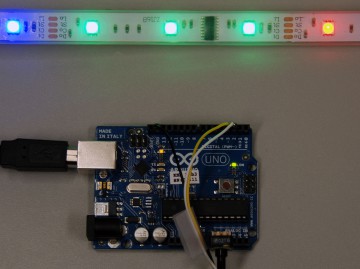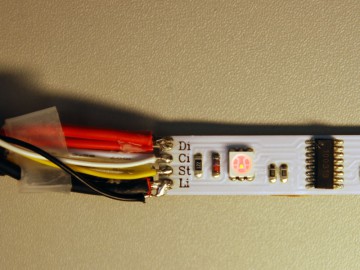Digital Addressable Led Strip & Arduino
Stripe Type Art Nr: EKXMAGICXSTRIPIP45 / 5 meter, available in Germany for about 100 Euros.
This stripe is 5m long with 150 RGB Leds which are organized in groups of 3 Leds. Each group is addressable individually, so always three leds in a group are showing the same color.
Similar to those strips with a HL1606 or LPD8806 controller this strip carries a 100313 device with an SPI interface.
In general the led strip is a very long shift register which is fed with RGB data and afterwards with zeros as latch command.
More details you will find on adafruit website where we started with.
Here we send a chain of 16 bit RGB datawords followed by a series of zeroes.
Each dataword consists of 3 x 5 bit color data and one bit always 1.
Connections
datapin: Arduino pin2 > St – led strip
datapin: Arduino pin3 > Ci – led strip
datapin: Arduino GND > Li – led strip
Arduino Code
/* Digital RGB LED Stripe testprogram
/* for Stripe Type Art Nr: EKXMAGICXSTRIPIP45
/*
* Lab3 12/2011 Nawrath
* Kunsthochschule fuer Medien Koeln
* Academy of Media Arts Cologne
* http://interface.khm.de
thanks to adafruit, ideas have be taken from the
Arduino library for the LPD8806-based strip.
This program is free software: you can redistribute it and/or modify
it under the terms of the GNU General Public License as published by
the Free Software Foundation, either version 3 of the License, or
(at your option) any later version.
This program is distributed in the hope that it will be useful,
but WITHOUT ANY WARRANTY; without even the implied warranty of
MERCHANTABILITY or FITNESS FOR A PARTICULAR PURPOSE. See the
GNU General Public License for more details.
You should have received a copy of the GNU General Public License
along with this program. If not, see .
*/
int datapin = 2; // Led Strip St Pin
int clockpin = 3; // Led Strip Ci Pin
int pinLed=13; // Arduino Led Pin 13
#define nled 49 // total number of controlled leds
unsigned int rgbPixel[nled]; // rgb values of whole led strip
unsigned int cc; // color
int r,g,b;
void setup() {
Serial.begin(115200);
Serial.println("DIGITAL LED STRIP TEST");
pinMode(clockpin,OUTPUT);
pinMode(datapin,OUTPUT);
pinMode(pinLed,OUTPUT);
r = random(31);
g = random(31);
b = random(31);
}
//*********************************************************
//*********************************************************
void loop() {
// uncomment function :
colorChase(wheel(random(96)),50) ;
// randomFlash(50);
// rainbowWheel(100,2);
// test();
// lightBarPot();
digitalWrite(pinLed,!digitalRead(pinLed)); // blink arduino led pin 13
}
//*********************************************************
// send color values from pixel array to led strip
void show() {
unsigned int ii,b1;
for (ii=0; ii < nled; ii++ ) {
bitWrite(PORTD,datapin,HIGH);
bitWrite(PORTD,clockpin, HIGH);
bitWrite(PORTD,clockpin, LOW);
for ( b1=0x4000; b1; b1 >>= 1) {
if(rgbPixel[ii] & b1) bitWrite(PORTD,datapin, HIGH);
else bitWrite(PORTD,datapin, LOW);
bitWrite(PORTD,clockpin, HIGH);
bitWrite(PORTD,clockpin, LOW);
}
}
latchLeds(nled);
}
//*********************************************************
// activate new color pattern in ledstrip
void latchLeds(int n) {
bitWrite(PORTD,datapin, LOW);
for(int i = 8 * n; i>0; i--) {
bitWrite(PORTD,clockpin, HIGH);
bitWrite(PORTD,clockpin, LOW);
}
}
//*********************************************************
// set color value as rgb argument , values = 0..31
unsigned int color(int r, int g, int b) {
// color are 3 groups of 5 bit (0..31)
r=r & 0x1F;
g=g & 0x1F;
b=b & 0x1F;
return (b << 10) | (r << 5) | g;
}
//*********************************************************
void colorChase(unsigned int c, int wait) {
int i;
for (i=0; i < nled; i++) {
rgbPixel[i]= c;
if (i == 0) {
rgbPixel[nled-1]= 0;
}
else {
rgbPixel[i-1]= 0;
}
show();
delay(wait);
}
}
//*********************************************************
void rainbowWheel(int wait,int wave) {
static int si;
int ii;
for (int i=0; i < nled; i++) {
ii=i+si;
if (ii > 95 ) ii=ii-96;
rgbPixel[i]=wheel(ii);
}
si=si+wave;
if (si > 95 ) si=0;
show();
delay(wait);
}
//*********************************************************
void randomFlash(int wait) {
for (int i=0; i < nled; i++) rgbPixel[i]=0x0;
r = random(31);
g = random(31);
b = random(31);
rgbPixel[random(nled)]= color(r,g,b);
show();
delay(wait);
}
//*********************************************************
// colorwheel with 96 colors, 0..95
unsigned int wheel(int WheelPos)
{
byte r, g, b;
switch(WheelPos / 32)
{
case 0:
r = 31 - WheelPos % 32; //Red down
g = WheelPos % 32; // Green up
b = 0; //blue off
break;
case 1:
g = 31 - WheelPos % 32; //green down
b = WheelPos % 32; //blue up
r = 0; //red off
break;
case 2:
b = 31 - WheelPos % 32; //blue down
r = WheelPos % 32; //red up
g = 0; //green off
break;
}
return(color(r,g,b));
}
//*********************************************************
void test() {
int aa;
pinMode(14,OUTPUT); // connect a potentiometer with input,wiper,output to
pinMode(16,OUTPUT); // analog pins A1,A2,A3
digitalWrite(16,1); //
aa= analogRead(15)/32;
rgbPixel[0]=color(aa,0,0);
rgbPixel[1]=color(0,aa,0);
rgbPixel[2]=color(0,0,aa);
show();
delay(100);
}
//*********************************************************
// light bar controlled by analog pin 1 ( potentiometer )
void lightBarPot() {
int aa;
pinMode(14,OUTPUT); // connect a potentiometer with input,wiper,output to
pinMode(16,OUTPUT); // analog pins A1 pot+,A2 pot-wiper,A3 pot-
digitalWrite(16,1); //
aa= analogRead(15);
Serial.println(aa);
aa= (500-aa);
aa=aa/5;
aa=aa+25;
for (int i=0; i < nled; i++) {
rgbPixel[i]=0x0;
if (i < aa) rgbPixel[i]=color(31,31,31);
}
show();
delay(5);
}
Video
lightBarPot() shows an example how the potentiometer position controls the length of a lightbar
Contact
Martin Nawrath, nawrath@khm.de



